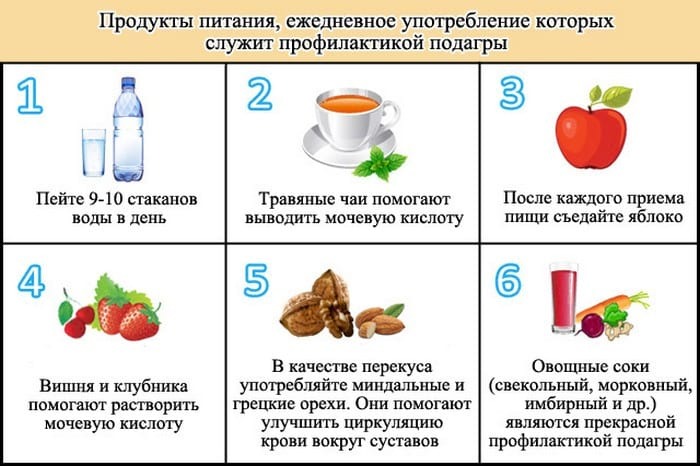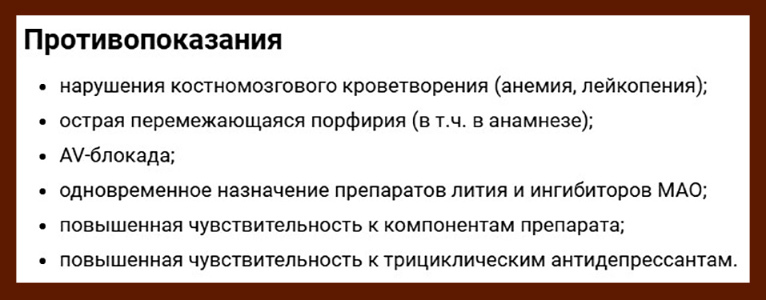Content
- Characteristic
- Manifestations
- Homans symptom
- Moses symptom
- Causes
- What diseases are associated with
- Diagnostics
- Doppler ultrasonography
- MRI
- Phlebography
- Ultrasound
- Treatment methods
- Special motor mode
- Wearing a tight bandage
- Drug treatment
- Anticoagulants
- Thrombolytics
- Antiplatelet agents
- Phlebotonics
- Anti-inflammatory drugs
- Physiotherapy
- Surgical intervention
- Possible consequences and complications
- Video about Homans and Moses symptom
Homans and Moses-like symptoms help identify a person's thrombosis deep veins in the limbs. It is the definition of the disease according to these signs that allows the phlebologist to accurately determine the localization of the blocked vein and establish the degree of blockage for further research.
Due to the depth of the vein in the legs, the exact location of the vessel damage can only be determined by a special examination, after which treatment is prescribed. In the presence of positive results according to the Homans or Moses test, thrombophlebitis or blockage of blood vessels with blood clots is diagnosed. In the future, if the treatment is ineffective, the patient is shown a mandatory operation on the leg to preserve it.
Characteristic
The symptom of the Homans and Moses test is the most informative way to identify pathologies of the veins in the extremities. These 2 techniques allow, using simple manipulations, to determine the presence of a decrease in nutrition in the tissues of the lower legs and blood clots in the veins. The peculiarity of the samples makes it possible to make a diagnosis at the stage of 50% of the lesion of the vein area of thrombi and this significantly increases the effectiveness of the available treatment for patients.

Manipulation of the Homans and Moses symptom gives a positive result with a blockage of a vein in the calf or ankle. They allow, without special equipment, to identify tissue nutritional disorders in the limb below the knee. Moreover, the more painful during the procedure, the more clogged the vein in the leg. The symptoms of Homans and Moses make it possible to quickly rule out diseases that also give soreness in the legs. Namely, heart failure, trauma.
Manifestations
Homans and Moses' symptom helps to identify deep vein thrombophlebitis in areas where it is impossible to quickly diagnose by other means. In this case, the general symptoms of thrombophlebitis are always present in the patient.
These include:
- swelling of the legs when standing upright;
At the same time, the patient does not drink a lot of fluids and can actively take diuretics.
- feeling of severe discomfort, heaviness, or pain in your legs;
Such sensations gradually increase during the day and are especially pronounced in the evening.
- in rare cases, in patients, the temperature may rise locally in the limb;
The rise in temperature can be insignificant and occur at certain times of the day, most often in the evening.
- cyanosis of the limb;
Cyanosis does not develop everywhere, but can manifest itself locally on the affected areas of the skin.
- enlargement of skin veins, which become visible and appear volumetric above the surface of the skin.
In addition, in case of blockage of the veins of the legs below the knee, the Homans and Moses system allows to determine the disease, which give specific, but precise symptoms. To determine by these systems, it is required to lay the patient on a couch without a pillow and slightly bend his knees. Next, manipulations are carried out to determine deep thrombophlebitis.
Homans symptom
When thrombophlebitis is detected in the lower part of the legs according to the Homans system, the doctor bends the leg in the ankle area of the patient from the back. If, during flexion, the patient develops a severe sharp pain in the calves, then thrombosis of the leg below the knee is diagnosed and a positive test result. At the same time, in patients with blood clots in the thigh, no pain is observed.
At the same time, in patients with blood clots in the thigh, no pain is observed.
Moses symptom
To establish thrombophlebitis according to the Moses system, the patient is also placed in a supine position. The doctor first puts pressure on the lower leg in the back and then in the front. In this case, the patient should be sore. And when pressing simultaneously on the same area from below and from above or simultaneously from the sides, the patient does not have pain. This indicator determines the presence of a thrombus in the calf area and allows you to diagnose the disease in the early stages of formation.
This indicator determines the presence of a thrombus in the calf area and allows you to diagnose the disease in the early stages of formation.
Causes
Homans and Moses' symptom helps to identify a violation or cessation of blood supply to tissues in the extremities, which can lead to hypoxia. Thrombophlebitis is the main cause of the development of disorders. A thrombus is a blood clot, a piece of tissue or fatty deposits that stick to the vessel wall and significantly narrow or completely block its lumen.
The blood clot can gradually build up and grow in size, exacerbating the health condition. As a result of the blockage of the vein vessels, the pressure in them increases significantly, and the vessel may break off or there may be extensive tissue hypoxia. In this state, the patient experiences severe soreness in the limbs, the leg may become numb, and the sensitivity decreases sharply.
Thrombophlebitis is well understood. There is a list of factors that contribute to the onset of the disease.
These include:
- heavy weight;
With excess body weight, the body's cholesterol level rises, blood pressure rises, stress on the heart and fat deposits can appear in the veins. Most often, the legs suffer from this change.
- constant intake of drugs;
Frequent intake of certain types of drugs (hormones, oral contraceptives, coagulants, anesthetics, muscle relaxants) changes the composition of the blood, making it thicker and more saturated. Clots can form in the blood, which quickly build up on the walls and cause blockage of blood vessels. Often this phenomenon occurs during long-term recovery from surgery.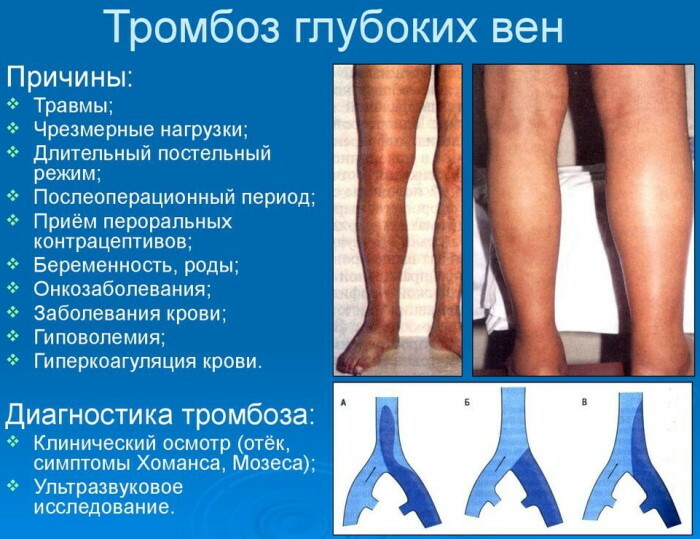
- age-related changes;
With age, in some patients, the state of the veins changes, the walls of which stretch and form bends. With such changes, the likelihood of vascular occlusion increases dramatically.
- trauma;
After injury to the lower extremities, the veins may not heal properly. Microcirculation is impaired on some tissues, and scars and scars interfere with normal blood supply.
- changes in the structure of the blood;
There are a number of diseases that cause changes in the homeostasis process and change the composition of the blood. Such diseases provoke the production of an increased number of platelets in the blood and an increase in blood viscosity. The patient has an increased risk of clogging of the vein with a blood clot, which can reach significant sizes. Thrombophilia can be congenital.
- high blood pressure;
Pressure above 135/85 is considered elevated. With this blood pressure, all veins are under increased stress, their functional ability changes, and the ability to narrow is reduced. As a result of this change, there is a gradual stretching of the vein, deformation and the creation of conditions for blockage of blood vessels.
- infectious diseases;
In acute infectious infections, pieces of pus, clots and tissue can enter the bloodstream, which catch on the walls of the veins and form a blood clot.
- slowing down the blood flow;
In case of violation of the blood flow rate in trauma, chronic and age-related pathologies, pregnancy, stagnant processes appear. Particles of blood can linger in blood vessels and form blood clots. Blood congestion often accompanies a sedentary lifestyle and increased body weight.
- damage to the vascular wall or endothelium.
In trauma, surgery and vein transplantation, endothelial and vein wall disorders occur. A change in the wall causes a decrease in the mobility of the vessel and the emergence of favorable conditions for the formation of a thrombus.
The appearance of thrombophlebitis can be facilitated by the disruption of the work of certain body systems during pregnancy, as well as with damage to the lungs.
What diseases are associated with
The symptom of Homans and Moses is an indicator of the development of thrombophlebitis in the extremities. Violation of vascular patency often accompanies chronic diseases that actively develop against its background.
These include:
| varicose veins | The expansion of veins and a change in their condition often accompanies thrombophlebitis. Blockage of veins leads to the build-up of pressure in them and their deformation. |
| heart failure | High blood pressure and impaired blood flow affects the work of the heart and blood vessels, causing heart failure, stroke. |
| rupture of a vessel | With thrombophlebitis, the likelihood of a vein rupture at the site of its blockage increases sharply. When the lumen of the vein narrows, the vessel can break off at any time and cause hemorrhage in the tissue. |
| arthrosis and arthritis | Violation of blood flow provokes blood stagnation, changes in the activity of tissue nutrition and their functionality. A person loses mobility, he may develop inflammatory processes in the tendons and bones. |
| chronic venous insufficiency | Chronic insufficiency of venous blood always complements the acute stage of manifestation of thrombophlebitis. In a person, when a vessel is blocked, venous blood stagnation occurs and its lack in the circulatory system. |
| post-thrombophlebitic syndrome | After the treatment of thrombophlebitis, the patient may develop post-thrombophlebitis syndrome or chronic venous insufficiency. The leg remains sore and heavy in the absence of blood clots. It is difficult for the patient to move. |
All concomitant diseases are characteristic of thrombosis, determined both with the Homans symptom and by the Moses test.
Diagnostics
The Homans and Moses test is the main way to diagnose thrombophlebitis in a patient. If a positive result is detected for the procedure, patients are assigned an examination to confirm the diagnosis and establish the localization of the injury site. Examination for thrombophlebitis of the limb below the knee includes:
Doppler ultrasonography
Duplex angioscanning of veins is a long-term ultrasound examination of the veins (popliteal veins, veins of the leg) of the leg for the presence of blood clots. In the process, the device establishes the degree of narrowing of the lumen of the vein and the permeability of the vessels. 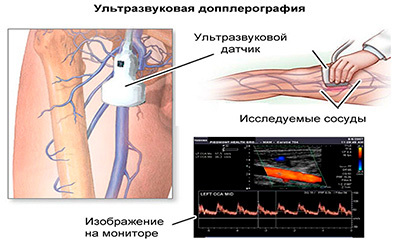 This method makes it possible to conduct a study on the deep tissues of the leg, to which the signal goes, to establish the length of the thrombus and its mobility. It allows you to explore large blood flows.
This method makes it possible to conduct a study on the deep tissues of the leg, to which the signal goes, to establish the length of the thrombus and its mobility. It allows you to explore large blood flows.
MRI
Magnetic resonance topography is based on the method of nuclear magnetic resonance. In the study, the limb is completely translucent, which makes it possible to obtain an image of the state of large vessels, the presence of blood clots and blood stagnation. MRI does not use rays, however, such a study is possible only if the patient has no contraindications.
Phlebography
Phlebography is an x-ray of large superficial venous vessels using a contrast agent. This study is the most accurate and allows you to generally assess the state of large veins. 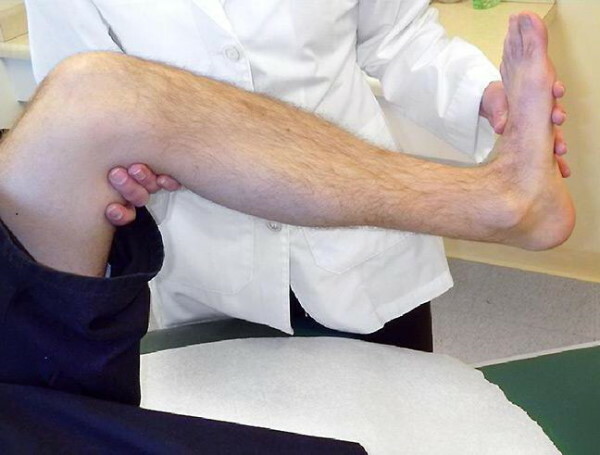 The study is used to establish the localization of the location of a hidden thrombus, changes in the size of the vessel, the degree of its blockage. The study must be carried out before vein surgery.
The study is used to establish the localization of the location of a hidden thrombus, changes in the size of the vessel, the degree of its blockage. The study must be carried out before vein surgery.
Ultrasound
In some cases, ultrasound can determine the condition of the popliteal vein and veins of the lower leg. Layer-by-layer study of tissues makes it possible to determine the place of formation of a thrombus in the leg, to establish the presence of stagnation of venous blood and to exclude tissue injury.
Treatment methods
When a blood clot occurs in the extremities, the patient is assigned an examination with constant monitoring of the state of health. The course of treatment includes:
Special motor mode
Patients are advised to exclude physical activity. More often during the day to rest, lie horizontally. When a vessel is damaged, it is important for the patient to periodically move, walk and follow a diet.
Wearing a tight bandage
To preserve the integrity of the vessel, the patient is recommended to bandage the leg with an elastic bandage for tight fixation of tissues. The bandage is used constantly throughout the day with interruptions of 30-40 minutes. Compression stockings can be used instead of an elastic bandage.
Drug treatment
Thrombophlebitis is treated according to the classical scheme with the help of medications. These are used as:
Anticoagulants
Anticoagulants thin the blood and reduce platelet count.  Drugs in this group (heparin, fragmin, warfarin) reduce the likelihood of a blood clot.
Drugs in this group (heparin, fragmin, warfarin) reduce the likelihood of a blood clot.
Thrombolytics
Thrombolytics (urokinase, purolase, screptokinase) promote the resorption of blood clots. Drugs in this group are prescribed for use only under the supervision of a physician and are used in minimal doses.
Antiplatelet agents
Antiplatelet agents (aspirin, courantil, choledol) further reduce blood viscosity. They relieve spasm and promote vasodilation. Their reception enhances the effect of antigoagulants.
Phlebotonics
Phlebotonics help to strengthen the walls of blood vessels, improve tissue regeneration and restore blood flow. They are able to relieve inflammation and prevent blood clots. These include Venarus, Detralex, Antistax. Topical preparations are also used to strengthen blood vessels. Detrogel improves blood microcirculation. It removes stagnation of venous blood, relieves heaviness.
Anti-inflammatory drugs
Anti-inflammatory drugs (aspirin, ibuprofen) can quickly relieve inflammation in the tissues, remove puffiness. They contribute to rapid healing and restoration of the state of blood vessels.
They contribute to rapid healing and restoration of the state of blood vessels.
Physiotherapy
With minor disturbances in the nutrition of the tissues of the extremities, methods of physiotherapy are actively used. Physiotherapy (magnets, electrophoresis) helps to relieve limb swelling and inflammation, to restore tissue condition. After completing the course, the vessels in the leg are strengthened, venous blood flow is restored.
Surgical intervention
If it is impossible to correct the condition by classical methods, the patient undergoes surgical treatment, which can be carried out in several ways:
- phlebectomy, in which the damaged part of the vein is removed.
- installation of a probe, which is installed in the intravascular lumen to expand the vein;
- laser vein correction, in which deformed areas of veins are removed and their condition is restored.
Vein operations are performed only if indicated and with the appointment of long-term restorative therapy.
Possible consequences and complications
The symptom of Homans and Moses is a manifestation of venous thrombosis in the extremities. After the appearance of a small blood clot, tissue malnutrition does not immediately make itself felt. As the situation worsens and the intravascular lumen decreases, the patient's state of health sharply worsens. There is heaviness in the legs, soreness, swelling and cyanosis of the outer covers.
When thrombophlebitis is detected, it is important to immediately undergo an examination and begin treatment.
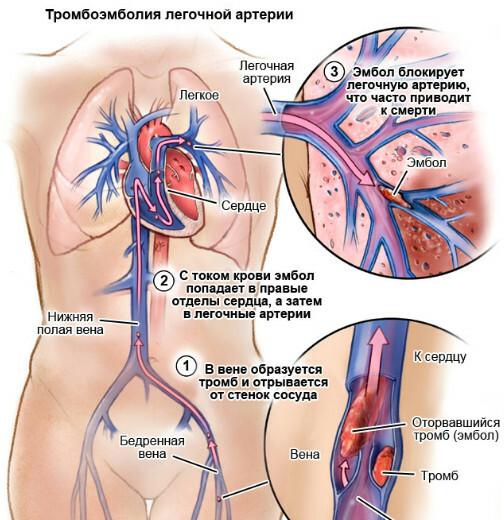
In the absence of timely therapy, patients may:
- take away the leg, the sensitivity in it disappears;
- break off the vessel in the leg;
- internal hemorrhage appears;
- there is a blockage of the femoral and other large veins with a detached thrombus;
- hypoxia of individual organs and tissues (limbs, heart, lungs) occurs;
- sepsis of blood appears;
- start inflammatory processes in the tissues up to the amputation of the limb.
Symptoms of the Homans and Moses type tests allow doctors to determine the presence of blood supply disorders in the legs in patients within a few minutes. Thrombophlebitis is a common disease and is easily diagnosed with modern methods.
With early detection, effective treatment can be provided by drug therapy with physiotherapy and a change in lifestyle. Scrupulous implementation of all the doctor's prescriptions allows you to quickly restore health to patients of any age and remove all symptoms of the disease.
Video about Homans and Moses symptom
Homans symptom:


